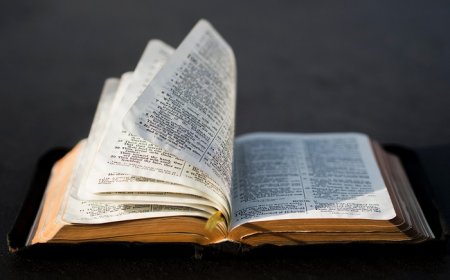What Are the 5 Offerings in the Book of Leviticus
The Book of Leviticus is one of the foundational texts in the Old Testament.

TheBook of Leviticus?is one of the foundational texts in the Old Testament. It is the third book of the Bible and forms part of the Law, or Torah, which includes Genesis, Exodus, Leviticus, Numbers, and Deuteronomy. While some readers may find Leviticus difficult to understand at first, its structure and content are essential to the understanding of Israel's worship, holiness, and relationship with God.
The word Leviticus comes from the tribe of Levi, the priestly tribe assigned to care for the tabernacle and conduct worship. The book provides detailed instructions for the Levites and for the people of Israel. These instructions include laws about rituals, sacrifices, purity, and holy living.
At the heart of theBook of Leviticusare five main types of offerings. These offerings were not only religious acts but also served spiritual and social purposes. They were acts of worship, expressions of repentance, and celebrations of Gods presence. Each offering had its own purpose and meaning. Through these offerings, the people maintained their covenant with God and found a way to live in His holy presence.
In this article, we will explore the five main offerings in theBook of Leviticus. Each one reveals something important about human needs and Gods provision. Though we no longer follow these rituals today, the spiritual truths behind them remain important. Understanding these offerings helps us better grasp the message of Leviticus and the broader story of the Bible.
The Burnt Offering
Complete Surrender to God
The first offering introduced in theBook of Leviticusis the burnt offering. It is described in Leviticus chapter 1. This offering involved the complete burning of an animal on the altar. Nothing was kept for the priest or the person bringing the sacrifice. Everything was offered to God.
The burnt offering symbolized total dedication. It was a voluntary act of worship. The person bringing the sacrifice was expressing their complete surrender to God. This offering pleased God because it came from a willing heart.
Today, the lesson of the burnt offering teaches us to give ourselves fully to God. We may not offer animals, but we can still dedicate our lives to Him. The principle remains: God desires wholehearted devotion.
The Grain Offering
A Gift of Gratitude
The second offering in theBook of Leviticusis the grain offering, described in chapter 2. This offering involved fine flour, oil, and incense. It was often offered along with the burnt offering. Unlike the burnt offering, this one did not involve animals.
The grain offering was an act of thanksgiving. It expressed gratitude for Gods provision. It reminded the people that all good things come from God. Part of the offering was burned on the altar, and the rest was given to the priests as food.
This offering teaches us to thank God for our daily needs. It reminds us to give back a portion of what we have received. Gratitude is an important part of worship. In todays world, we can still learn from this spirit of giving thanks.
The Peace Offering
Fellowship and Joy
The third offering described in theBook of Leviticusis the peace offering. It is also known as the fellowship offering and is discussed in chapter 3. This offering was unique because the worshiper, the priest, and God all shared in it. A part of the animal was burned on the altar for God, a part was given to the priest, and the rest was eaten by the person who brought it.
The peace offering symbolized fellowship with God and with others. It was often offered in times of celebration. It marked moments of joy, thankfulness, or fulfilled vows. It was a communal event, not just a private ritual.
This offering reminds us that worship is not always solemn. There is a place for joy and celebration. God desires peace with His people, and He wants us to live in harmony with one another. The peace offering shows that worship can also be a time of unity and delight.
The Sin Offering
Cleansing from Guilt
The fourth offering in theBook of Leviticusis the sin offering, explained in chapters 4 and 5. This offering dealt with unintentional sins. It made atonement for the person who sinned and cleansed the place of worship from impurity.
Different animals were offered depending on the status of the person. A priest, leader, common person, or the whole community might bring a different animal. The goal was the same for all: to receive forgiveness and be restored to God.
This offering reveals the seriousness of sin. Even unintentional sins needed to be confessed and cleansed. It shows Gods holiness and His mercy. He provided a way for people to return to Him when they failed.
Today, we may no longer bring animal sacrifices, but we still need forgiveness. The message of the sin offering teaches us to take our sins seriously and to seek Gods grace with humility.
The Guilt Offering
Restoring What Was Broken
The fifth offering in theBook of Leviticusis the guilt offering. It is sometimes called the trespass offering and is found in chapters 5 through 7. This offering was brought when someone had sinned against God or another person. It involved paying back what was lost or stolen, along with a fine, and then bringing a sacrifice.
The guilt offering was about more than forgiveness. It was about making things right. It involved action, not just words. The person who brought the offering had to show true repentance by correcting their wrong.
This offering teaches us that repentance includes restoration. When we hurt someone, we should seek to make it right. God desires not only confession but also transformation. True worship involves justice and responsibility.
Conclusion
The five offerings in theBook of Leviticusreveal a deep and meaningful pattern of worship. They show us how the people of Israel related to God through acts of devotion, gratitude, peace, repentance, and restoration. Each offering had a specific role, but together they formed a complete picture of spiritual life.
TheBook of Leviticusmay seem distant to modern readers, but its teachings are still alive. It reminds us of God's holiness and His desire to live among His people. It teaches us how to approach Him with respect, love, and honesty. Through these offerings, we see the seriousness of sin, the beauty of peace, and the joy of fellowship with God.
As we read theBook of Leviticustoday, we are called to reflect on our own worship. Are we giving our best? Are we thankful for what we have? Are we seeking peace and living in truth? These questions still matter. The offerings may no longer be required, but their lessons continue to speak to every heart that seeks God.























